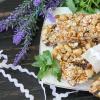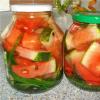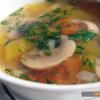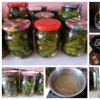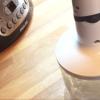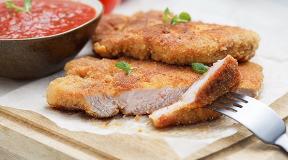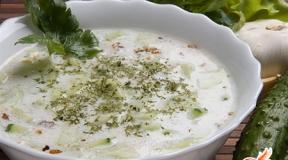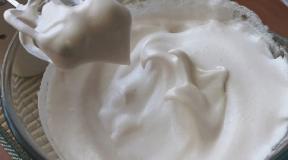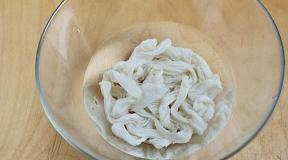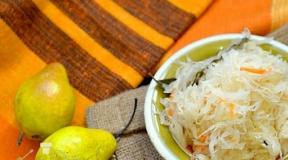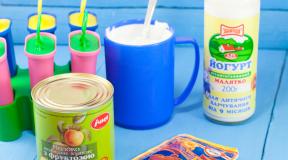How to make a loofah from the fruits of a loofah. Luffa is a natural washcloth. Plant care
All my childhood I washed myself with a natural loofah loofah! The most interesting thing about this is that I did not even suspect that this is a loofah! Its interesting shape, fibrous, porous structure did not give me the idea that it was a dried fruit!
Having matured, I asked myself a question - where does the raw material for this natural washcloth come from ... Honestly, there was no limit to my surprise! So what is loofah?
In common people, it is customary to write the word loofa with one letter F. However, the name is spelled correctly with two letters f, that is - luffa!
Luffa is an annual plant from the genus of herbaceous lianas. It belongs to the pumpkin family, although in appearance it looks very much like a huge cucumber!
Among the people, Luffa got a funny nickname - mad cucumber. Fruit sizes can reach up to 50-70 cm, weight from two to three kilograms, and the liana itself has a length of 3 to 6 meters. When dry, the weight of the fruit is significantly reduced.

Luffa prefers tropical and subtropical climates, but it also grows in warm regions. Many lovers of summer residents successfully cultivate and grow luffa. The plant is whimsical and has its own "requests". At proper care, attention and care, as well as good climatic conditions on fertile soil, you can get more than three fruits from one bush!
Luffa varieties
There are more than 50 types of luffa, but only two types of plant have spread. The rest of the plant species give too small fruits, and they require a lot of care. Therefore, it makes no sense to grow them.
- Luffa sharp-ribbed
Young fruits of the sharp-ribbed luffa are used for cooking. It is stewed, boiled, added to other dishes. It can be eaten raw and even canned. The pulp of young shoots is juicy, sweetish (very similar to the taste of cucumber).

But when the fruit ripens, the pulp turns into dry fiber. When the fruit dries up completely, a sponge of woven dry fibers forms inside. It is taken from the dried fruit and used to make washcloths, rugs, mattress fillers, and even for making hats. And from the pressed sponge, the luffa is used to make filters for isolation.
- Luffa cylindrical (or Egyptian)
This species produces fruits that are smooth, cylindrical or club-shaped. This plant is often referred to as loofah loofah. However, cylindrical loofah can be used not only for the manufacture of washcloths.

Its area of application is the same as that of sharp-ribbed relatives. But, most often, natural washcloths are made from it. This species has tender and juicy flesh, tender and thin skin, which is easy to peel from dry fruit.
How to make a loofah loofah
In order for a wonderful bath attribute to turn out from a huge fruit, you need to know some subtleties.
Only from ripe fruits can you make a loofah, that is, the pulp inside should dry out. The color of the fruit will help you find out the exact time, when it turns brown - the time has come! And, of course, do not forget about the dry tip at the end.
If the fruits did not have time to ripen (for example, they were unlucky with the weather), then they can be picked green and dried in a warm, dry room.
In order to easily get the skeleton of a washcloth, you must first work with the fetus. Some summer residents advise to soak the luffa skin for several days in water to soften it. But, there is a more practical way:
Dip the dried fruit in boiling water for 10-15 minutes, then cool and the skin is easy to peel. Once you get your future loofah, look at the fibers to the light. Amazingly many seeds, right !?

It is also necessary to get rid of the seeds, this can be done in two ways - pick out or lower the washcloth in water. The seeds have to get out of the fibers on their own.
After a real loofah washcloth appears in your hands, rinse it in soapy water, then in clean water and let dry in free air. Now it's time for your imagination! You can sheathe the loofah with a soft cloth, cut it into convenient pieces, make double-sided washcloths - in general, whatever you want!
How does a loofah washcloth work on the skin
Any natural sponge is tough and loofah is no exception to this rule. The fiber has dried, hardened and become a tough material. Not sissies like to wash with such a washcloth. Who wants to enjoy an excellent skin massage besides washing - this washcloth is just for you!
Excellent massage effect, deep cleansing of pores, natural skin exfoliation and maintenance of its tone - this is what a loofah washcloth can offer you. Although this washcloth is particularly hard, it acts softer on steamed skin in a bath.
After washing, the skin becomes firm and taut. In the prevention of cellulite formation, the loofah washcloth takes the first place!
How to make a loofah soft
Not all supporters of a harsh action on the skin. But, since everything natural in itself is very useful for us, it is possible to make a delicate and pleasant body sponge from a hard loofah.
Children, elderly people and those who want to keep their beautiful summer tan as long as possible like to wash with a soft washcloth. There is still a way out of the "tough" situation.

To make the washcloth soft - brew it with boiling water, cover with a lid and let it “sweat” for 10-15 minutes. This is, in principle, the whole procedure, the washcloth will become softer, and it can be used to wash sensitive and delicate skin.
Everything is much simpler in the bathing kingdom! Father himself, bath heat and steam softens the tough fiber. That is why I was not afraid as a child of this hard washcloth, the bath itself made it soft.
Of course, there is another way to make the washcloth soft. It is made double-sided, that is, it is sewn on one side of the luffa soft tissue or a sponge. The sponge can also be placed inside the skeleton of the loofah, this will give twice as much soap suds, which will naturally reduce the rigidity of the washcloth.
How to care for a washcloth
The problem with all natural washcloths is that painfully different bacteria and microbes like to arrange their own in them. permanent place residence. Here is one more proof that all living things in the world love natural things!
Only, if you want to use a loofah washcloth as long as possible, you shouldn't allow "lodgers" into its porous structure. They will simply eat your washcloth, the fibers will creep, it will deteriorate and break.
That is, care for the washcloth is definitely needed! After use, rinse it thoroughly, pour it over with boiling water and be sure to dry it! In the bathhouse, the drying process happens somehow by itself - the kingdom is hot, the queen of the oven rules the ball and dries everything up!

But in an apartment, in a wet bath, the life of a washcloth is significantly reduced. You can try to dry it in the winter on a hot radiator, and in the summer in the open air (for example, on the balcony).
This is my story about a natural loofah loofah. Of course, there are no identical people, everyone has different tastes and preferences. But, this washcloth has "taken root" in our family for so long that I recommend you to get acquainted with it. It seems to me that you will not be disappointed!
Looks like a washcloth? Yes, this is not a mistake, it is called luffa - exclusively of natural origin. It can be used as directed after absolute drying. There are about 50 species in the world, a plant native to the humid tropics.
Description and features of the luffa
Luffa– plant from the genus of herbaceous lianas, belongs to the pumpkin family, reaches a length of more than 5 meters. The natural habitat is Asia and Africa, their tropics and subtropics. Strongly branched, has the ability to weave and cling to that growing in the neighborhood.
Leaves are of medium size, whole, sometimes lobed with five or seven divisions. During flowering, it throws out the brushes, along which there are large dioecious, painted in yellow or white tones. The stamens are in compact inflorescences, and the pistils are slightly distant.
Luffa seeds are located in fruits, elongated and cylindrical in shape, resembling a cucumber. The fruit is dry inside, has a fibrous structure. Sometimes the fruits can reach enormous sizes (5-7 meters), for which they are popularly called "mad cucumber".

The process of seed ripening in the fruit is interesting and unusual. Mucus forms inside the fibrous part, a hole appears above or below. From it "shoots" seeds into space.
Planting and breeding loofah
How to grow a luffa? There are two effective ways: seedling and sowing seeds in open ground... The plant has a long growing season, because gardeners will unanimously say that quick way breeding is.
Seeds are sown in the month of April. They take small containers (no more than 9 cm in diameter) with peat, plant them to a depth of 2 cm. The seeds are preheated and soaked in warm water for half an hour. Water abundantly and cover with polyethylene.

Install temperature regime up to +30 ° С. The sprouts should appear on the 7-10th day, then the temperature is reduced to +20 ° C. Before planting in open ground, seedlings are watered with organic.
Luffa is planted in May / June, when the night air temperature will no longer be lower than +15 ° C. The plant loves fertile loose soil, a lot of light, but does not tolerate strong drafts.
Growing Luffa do not forget about top dressing, fertilizers are applied in two or three passes: during planting, during several loosening. Manure, superphosphate and ammonia are used.
In the vegetation stage of 5-6 leaves, tendrils appear in the luffa. Now we need to think about the support, the plant will start looking for an item for weaving. When the sprouts are still small, the support is installed immediately so as not to damage the root system. It is better if a wooden or reinforcing structure is used as a support.

Growing luffa at home, you need to make sure that the bed is large. planted at a distance of one meter from each other. Dig holes with a diameter of 30 cm and a depth of 15-20 cm.Immediately pour manure or compost into the holes.
Luffa care
Luffa not whimsical in care, the only drawback is too long a period of growth. This is due to the fact that it increases the abundant mass of leaves, and one specimen also has many fruits.
It is during the period of active growth that the loofah must be fertilized. This refers to organic fertilization, twice a month. In 10 liters of water, 1 kg of mullein and a glass of ash are bred. Mix well, leave for one hour and water.
Very demanding on moisture, the root system is weak, all the liquid accumulates in the leaves / stems, then evaporates. High humidity is also important, you can combine watering with spraying using a water hose.

The watering scheme is as follows: immediately after planting the seedlings, the plant is watered once a week; from June to September - once every three days. When the luffa enters the fruit ripening phase, watering is reduced.
In order for the fruits to develop correctly and ripen in time, the stem must be pinched correctly. This method will help shorten the lengthy growing season. Extra branches are removed from the root, at a distance of about 3 meters.
The remaining fruits will form the same size and shape, which is very important for industrial purposes. The harvesting of ripe fruits must be planned in advance, preferably before the onset of frost.
If agricultural technology and general care selected correctly, you can get excellent loofah sponges natural origin. Besides this, it has many useful properties.

The most significant are the abundance of fiber, vitamins of groups A and C, mineral salts of potassium and phosphorus, folic acid, carotene and iron. Tinctures are used for diseases of the nose, joints, anemia and bronchitis.
Types of luffa
In nature, there are several dozen types of luffa, man cultivates only some of the main varieties:
*Luffa cylindrical- breeders call it "scaly", forms huge fruits, reaching 60-70 cm in length, pointed at the base. The outer coat is light green, thin, the skin can be easily peeled off.

The pulp is light inside, tender, uniformly porous. This kind loofah loofahs specially grown for the manufacture of environmentally friendly hygiene products.

* Sharp-ribbed Luffa - this variety is grown for food use. Ripe fruits reach a length of 30-35 cm, acquires different shape(cones, clubs, with ribs), the inside is a dense and spongy tissue.
This variety is notable for the fact that the fruits ripen much faster than other subspecies. Not particularly demanding in care, rarely exposed to fungal diseases.
* Luffa Egyptian similar to the sharp-ribbed variety. They are used in food in different ways:

Boil, stew, bake, canned. Often this type of loofah is used not only as a natural massage washcloth, but also as a natural filter. Recently, the material has been added to improve blood circulation in rugs, hats, chair covers and the like.
If you decide to grow natural loofah on your own, choose only certified seed. Buy Luffa Seeds available at any garden store or farm themed department.

If you are going to sow into the soil, carefully examine each seed. If the material is healthy, then there should be no fungal lesions, blackness, dents and mechanical damage.
To get an excellent material for a washcloth, ripe fruits are hung to dry. This can be a dry, well-ventilated area.
To quickly remove the upper skin, the dried fruit is placed in boiling water for several minutes. The porous sample is rinsed with soapy water and suspended again until dry.

If you look closely photo of luffa, then everyone will say that this is an excellent material for creating compositions and decor. Designers do not get tired of coming up with more and more new applications for it.
For example, a luffa cup is able to retain heat for a long time. Dried is used for furniture elements, during the manufacture of jewelry, in soap making, and so on.

After rereading the many reviews about luff, the following advantages can be distinguished: improves blood circulation, cleanses the upper keratinized sphere of the skin, does not cause allergic reactions, has a lymphatic drainage effect, excellent prevention of stretch marks and cellulite. It is advisable to change such a washcloth every six months, buy luffa regularly.
Choosing seeds, I saw a bag of luffa, read the annotation, and got interested. My children are allergic, so we need natural washcloths. What is Luffa? How to grow seedlings, at what time should they be planted in a greenhouse? Is it possible to transplant grown plants into open ground so as not to occupy the greenhouse area?
Luffa is a genus of annual liana-like plants belonging to the pumpkin family. Washcloths are made from the ripe fruits of a cylindrical luffa, it is its seeds that are on sale. It is worth noting that, in comparison with polymer washcloths, natural ones better clean off dead skin particles and do not cause allergic irritation. Dried luffa fruits are well stored and can be used for several years. Unripe fruits and leaves are used for food (they contain 1.5 times more carotene than carrots).
It looks like a luffa plant with fruits in the photo
The growing season of luffa is long, so seedlings should be grown even in the southern regions. It is advisable to do this in the first decade of March. When growing luffa from seeds at home, before sowing, they must be disinfected by placing them in a solution of phytosporin or potassium permanganate for 20 minutes, rinse under running water, treat with a growth stimulator and spread on a damp cloth for germination. Luffa seeds germinate at a temperature of about 28-30 ° C. The container with seeds can be placed on the battery by placing a towel folded in several layers. The fabric must not be allowed to dry out; it must be constantly wet.
If sprouts do not appear within a week, then the seeds can be helped by carefully opening the valves. Seeds that have hatched should be immediately planted in separate containers (at least 400 ml) with disinfected light nutrient soil to a depth of 2 cm. Before emergence (3-4 days), the sowing container should be covered with a transparent film. To prevent mold from forming on the surface of the soil, the crops must be ventilated daily, if necessary, moistened.

Luffa shoots are very similar to cucumber
From the moment of germination, the container must be moved to a light windowsill, removing the film (glass). The moisture content of the soil should be treated carefully, it is highly undesirable to allow it to dry out. The optimum temperature for the growth of seedlings, very similar to cucumber, is about 20 ° C. Luffa is developing rapidly. After 5 true leaves, tendrils begin to form, support is required.
If the greenhouse is heated and the night temperature does not drop below 15 ° C, then it is more convenient to grow Luffa seedlings in the greenhouse. If the temperature regime in the greenhouse differs from the specified one, then it makes sense to grow the seedlings indoors, and then transplant them into open ground or a greenhouse. It is advisable to think over the question of supports for transplanting seedlings. Luffa is thermophilic, does not tolerate frost and a sharp drop in temperature. In regions with cool summers, it can only be grown in greenhouses.

Ripe and unripe luffa fruits
Given the rapid growth of the luffa (it can grow up to 7 m), at least 1 m should be left between adjacent specimens.It is convenient to plant it along a stretched plastic mesh (sold in specialized stores). Otherwise, the plants will suppress each other and develop worse. It is undesirable for plants to climb trees, because in this case, injury to the fruit and their subsequent decay is possible.
Luffa leaves are carved, pubescent. It blooms in July with large yellow flowers. Female flowers single, male - collected in brushes (2-3 pcs.). Insects willingly visit them, therefore, as a rule, there are no problems with pollination. Up to 12 fruits can be obtained from each plant. Unripe fruits can weigh up to 3 kg. When ripe, they dry out, their mass decreases.

Luffa seeds and fibers from ripe fruit
Luffa is moisture-loving, like cucumbers, the root system is superficial, so regular watering with warm water is required. It requires at least 5 dressings per season with complex fertilizers for pumpkin crops or similar. To accelerate the ripening of fruits, the central shoot can be pinched when it grows to 4 m. It is advisable to remove late-formed fruits so that they do not deplete the plant.
When the night temperature drops to 10 ° C, the fruits of the luffa must be harvested, even if they are not ripe, otherwise they may be amazed by anthracnose and it will be impossible to use them. Unripe fruits ripen well in a warm room, suspended.

Pictured is a ready-made loofah washcloth
When the luffa fruits turn yellow, the shell should be removed. Large seeds are located inside the fibers, they are easy to shake out. The "skeleton" must be washed from the pulp (if it has not all dried out) and dried well. The natural washcloth is ready.
Different plants have different properties useful to humans, and if some of them are used only for culinary or decorative purposes, others can serve in everyday life. The latter also includes loofah, known as a good raw material for the manufacture of bath sponges.
Luffa is a representative of liana-like plants, with shoots up to 4-7 m in length. All of them have branched antennae and roughness along the edges. Leaves are palmate-five-lobed (sometimes whole) and alternately arranged.
The outlines of the leaf plates resemble a heart with a diameter of 15-27 cm and teeth located along the edges. All of them evaporate a lot of moisture, so the plant needs regular watering.
Quite large loofah flowers are monoecious, dioecious, painted white or yellow.
Stamen varieties are collected in racemose inflorescences, while pistillate varieties are distinguished by a single arrangement. The flowering of the plant can be observed from June.  The green corrugated fruits of the plant resemble spindle-shaped "cucumbers", the length of which is about 50 cm, with a diameter of 7-12 cm. Immediately after ripening, they begin to dry, and sclerenchymal fibers develop in them.
The green corrugated fruits of the plant resemble spindle-shaped "cucumbers", the length of which is about 50 cm, with a diameter of 7-12 cm. Immediately after ripening, they begin to dry, and sclerenchymal fibers develop in them.
The seeds of such "cucumbers" have an ovoid shape and a marginal border. The length of the seed can be up to 1.2 cm. Full ripening of the fruits is noted towards the end of summer.
The liana rhizome is weak and is located in the surface layer of the soil.
Did you know?The described plant has many interesting names and, in addition to "loofah", liana is often called Vietnamese pumpkin, Chinese okra, bastard gourd and even mad cucumber.
Views
Today, there are about fifty types of loofah, but only two of them are used for growing in the garden: sharp-ribbed and cylindrical, and it is from the latter that popular loofah sponges are made.
This variety is represented by an annual liana, reaching a length of 3-6 meters. The pentahedral stems have rough edges on the edges and are fixed to the support using branched antennae.
The leaf blades reach 20 cm in diameter, in most cases they are 5-7-angular or divided into several separate lobes.
The attachment of the leaves to the stem is carried out by means of rather long petioles - about 8-12 cm each.
All the flowers of the plant are heterosexual and can have five 2-cm petals of a pale yellow color. Staminate species form racemose inflorescences, 17-20 in each, and pistillate ones are solitary and are located in the axils of the same leaves as staminate ones.
The fruits of the sharp-ribbed loofah are club-shaped and reach half a meter in length, with a diameter of 6-10 cm.  The taste of young specimens resembles cucumber, except that the pulp is sweeter. As soon as the fruits are completely dry, they are no longer suitable for food, but a fibrous sponge, created by woven conductive bundles, remains under the peel.
The taste of young specimens resembles cucumber, except that the pulp is sweeter. As soon as the fruits are completely dry, they are no longer suitable for food, but a fibrous sponge, created by woven conductive bundles, remains under the peel.
The seeds inside are egg-shaped and reach a centimeter in length. In ripe fruits, they are yellowish-black or completely black.
Sharp-ribbed loofah is grown for the use of young cucumbers for food purposes, in particular for the preparation of curries. Ripe fruits are unsuitable for eating, as they give off strong bitterness.
In cooking, the rest of the plant is also often used: buds, leaves, shoots and even flowers, and all that is needed to get a tasty side dish is simply to extinguish them or season with oil.
The cylindrical loofah is practically the same liana-like plant as the previous variety, but its length is slightly longer - up to 9 m. The yellow flowers are just as large, and the unripe young "cucumbers" are an ideal ingredient for many dishes.  In length, they reach 60-75 cm, which is almost twice as long as that of the sharp-ribbed variety. As soon as the peel on the fruit turns yellow, they can be removed and started to peel, extracting the fibrous pulp itself.
In length, they reach 60-75 cm, which is almost twice as long as that of the sharp-ribbed variety. As soon as the peel on the fruit turns yellow, they can be removed and started to peel, extracting the fibrous pulp itself.
Important! Try not to overexpose the loofah on the bushes, because an overdried plant will be much worse to clean.
The cylindrical variety of "mad cucumber" is more suitable for making washcloths, although they do not disdain the plant in cooking: in addition to the fruits themselves, they use leaves rich in carotene (its content here is almost 1.5 times higher than that of such popular vegetables as carrots and sweet bell pepper).
Like many other plants, loofah is not yet recognized by official medicine, but its use will still be appropriate in a number of cases.
As we just mentioned, the fruits contain beneficial for human body fiber, in addition to which it is worth highlighting such important components as triterpenoids, pectins and carotene.
Cucumber juice is used to treat conjunctivitis and some dermatological problems, especially those associated with oily skin.
In addition, young fruits and even the ovary of Vietnamese pumpkin will be useful in the treatment of anemia, ailments of the respiratory system, or simply for a general strengthening effect on the body.  Luffa juice is an excellent ingredient for creating medicines for joint diseases or infusions for nasal diseases. Gruel from "mad cucumber" helps to eliminate cough and lower body temperature, which is why it is often used by the healers of the East.
Luffa juice is an excellent ingredient for creating medicines for joint diseases or infusions for nasal diseases. Gruel from "mad cucumber" helps to eliminate cough and lower body temperature, which is why it is often used by the healers of the East.
In addition, the vegetable will be equally useful for lactating women, as it helps to increase milk production. This list of usefulness can be continued for a long time, but it is clear that loofah is indeed a very valuable vegetable.
Despite the fact that many gardeners talk about the specifics of growing loofah, it can be planted in almost any area, both in open soil and in a greenhouse. 
Planting "mad cucumber" immediately into open soil, mainly engaged in residents of temperate climatic zones, where the summer is warm enough and the earth warms up quickly.
However, in colder climates, it is advisable to plant the plant in seedlings, especially if you are hoping for larger washcloths. The age of the seedlings at the time of moving to a permanent place of growth should not be less than 30-40 days.
In any case, it does not matter whether you sow seeds directly into prepared beds, or are going to plant seedlings in a box, the preparatory stage in both cases is the same:
- We are looking for quality seeds.
- We warm them up for a week on a battery or in direct sunlight (the main thing is that the temperature is at least +40 ° C).
- We soak in a solution of aloe juice (diluted in a 1: 1 ratio with water) to awaken and activate the growth function.
- We plant it in the soil (in a garden bed or in boxes).
 Loofah seeds If you decide to grow seedlings, then fill individual containers with loose, nutrient-rich soil, and deepen the loofah seeds into the substrate by 2 cm.
Loofah seeds If you decide to grow seedlings, then fill individual containers with loose, nutrient-rich soil, and deepen the loofah seeds into the substrate by 2 cm. Important! The plant does not tolerate transplanting well, therefore, in order to avoid unnecessary problems, experts advise planting seeds directly in peat pots or any other container made of organic material, with a diameter of at least 6-7 cm. Usually, the process of planting seeds occurs in April.
Having placed the seeds in the substrate and sprinkled them with a layer of soil, it remains only to pour them with water and, covering the boxes (or pots) with plastic wrap, place them in a warm place, waiting for the appearance of strong sprouts.
An ideal place for placing seedlings will be a window sill above a warm battery or on the sunny side of the house, since the optimal temperature indicators for germination of seeds and their rapid growth values within the range + 28… + 30 ° C are considered.
The first shoots usually appear 6-8 days after planting, and as soon as this happens, the containers with young plants should be moved to a cooler room, with a temperature of no more than + 20 ° C.  When all the sprouts are fully grown, the film is removed and the seedlings are added with infusion diluted in water in a ratio of 1:10. Such a nutritious infusion will accelerate the growth of the loofah, and when 6 true leaves appear, it will need to be tied to a support.
When all the sprouts are fully grown, the film is removed and the seedlings are added with infusion diluted in water in a ratio of 1:10. Such a nutritious infusion will accelerate the growth of the loofah, and when 6 true leaves appear, it will need to be tied to a support.
Young plants are planted in open areas only after the average daily temperature is set at +13 ° C. Seedlings are placed in even rows, with a sufficiently large distance (1 m). This requirement must be met, given the size of the leaves of the vine.
When planting seeds directly into open soil (more suitable for growing loofah for gastronomic purposes), you need to organize pits 30x30 cm in size and 25 cm deep in advance, filling them up to half with cow dung mixed with soil. The seeds are placed in this mixture, sprinkling them with the remaining soil.
The seedling method is much more profitable than the seed method, because by planting the loofah in pots in advance, you get not only an early, but also a very rich harvest.
When choosing a place on the site for growing such an unusual cucumber, you should pay attention only to well-lit and wind-protected areas with fertile soil and a sufficiently deep groundwater.
Loofah loves the sun very much, which means that a lack of sunlight will lead to limited plant growth and a less plentiful harvest. 
Care
Taking care of the planted plants is not very difficult, and you only need to perform a few regular procedures:
- watering - 1-2 times a week;
- loosening - a few hours after watering;
- removal of weeds - in the process of loosening.
At the end of summer, the abundance of watering is reduced, which is necessary to shorten the growing season and accelerate the ripening of the crop.
One more, no less important aspect care for the loofah is feeding the plant. The first fertilizer is applied already at the time of planting, at the rate of 5 kg of manure per 1 sq. m plot.
In addition to manure, complex mineral compositions are used, with the participation of, and. The specific dosage of each such agent is calculated based on the characteristics of the soil on the site (the instructions on the package will help you navigate in approximate values).
In the future, as the loofah grows, fertilizing is carried out regularly 2-3 times every 30 days, for which a special mixture is used, prepared from a glass, 1 kg of mullein and a bucket of water.
During the flowering period, vines can be fed with nitrogen-containing compounds, again calculating the proportion based on the norms indicated on the package. 
The specific timing of harvesting the fruits of the loofah directly depends on the purpose of its cultivation. If you are interested in the use of "mad cucumbers" in cooking, then you need to shoot them still green, around mid-late August with a length of 10-15 cm.
Did you know? Hot tropical countries are considered the birthplace of luffa: India and Africa, and the latter still has lands that people have not yet visited.
After lying down for a while, they will become an excellent raw material for further processing into canned food or simple stewing.
However, if the plant is grown in order to get a good washcloth, then you will have to leave the fruits on the bushes for a longer time so that as much moisture as possible is removed from the pulp.  You can also cut them off at the end of the growing season (at the end of September) and hang them in a dry and warm room so that they do not come into contact with each other, otherwise rot may begin from dents.
You can also cut them off at the end of the growing season (at the end of September) and hang them in a dry and warm room so that they do not come into contact with each other, otherwise rot may begin from dents.
To obtain soft washcloths, the period of "ripening" at home is slightly reduced.
When grown in warm climatic zones, loofah is considered fully ripe when the skin on the fruit turns yellow, and they themselves dry out quickly.
Scrubber making process
After successfully growing a loofah, it will not be difficult to make a loofah from a ripe fruit. The whole process takes place in the following sequence:
- Young or very brown fruits must be collected and dried well (temperature not less than +40 ° C), thereby preparing them for further processing.
- After drying, the plant is placed in water for a week in order to achieve maximum softening of its peel.
- Then you should remove the skin and peel the pulp from the fibers.
- It remains only to rinse the loofah again in water, rinse and leave to dry in the sun.
Video: how to make a loofah loofah After completing the process, you will have a finished washcloth in your hands, and all that remains is to make two holes at one end and thread a string through them for ease of holding. If you come across a long fruit, you can sew it with a nylon thread along the edge and connect the parts together, forming a circle.
Application
Loofah is widely used in various areas of human life: from cooking to cosmetology, and almost everywhere she simply has no equal. Let's consider the benefits of its application in each of them.
Important!If you do not grow vegetables on your own, then when choosing a loofah, it is advisable to pay attention to its external characteristics: the fruit should not have any lesions on the skin or overly soft, obviously putrid places.
Unripe loofah fruits have a very pleasant and delicate taste, reminiscent of a mixture of cucumber and zucchini, and in addition to this, a very fresh smell can be noted. Dense and thick peel is always peeled, since it is not suitable for food.
The flowers and buds of the above types of loofah are excellent for preparing salads: they are very crunchy, with original flavoring and aromatic notes. When using the leaves of the plant for these purposes, one should not forget about their bitter taste.  Young "cucumbers" can be eaten both raw and heat-treated: stew, fry, boil and even stuffed or pickled. Vietnamese pumpkin is also suitable for use in raw salads instead of cucumber.
Young "cucumbers" can be eaten both raw and heat-treated: stew, fry, boil and even stuffed or pickled. Vietnamese pumpkin is also suitable for use in raw salads instead of cucumber.
Important! For the preparation of various dishes, it is better to choose fruits up to 15 cm in length, since it is they, most often, that turn out to be the sweetest and most delicious.
With proper culinary processing, loofah can easily turn into a good side dish for meat or fish, and this applies to both fruits and shoots, buds and flowers. In addition, "mad cucumbers" are great for preparing first courses or vegetable stews, and the pulp will be an excellent addition to omelets.
For those who do not like to spend a lot of time in the kitchen, there are simpler options for making loofah: its fruits can simply be fried in olive oil, using cayenne pepper and soy sauce. With a little more effort, you can cook stuffed vegetables, with the addition of rice or meat, and in China, loofah with pork and mushrooms is especially appreciated.
In a word, the plant can be combined with almost any product, but options with the use of soy sauce will be especially successful, olive oil, garlic, pepper, seafood, beans, rice and rice noodles.
The yellow flowers are perfect for a nice fresh salad, and the seeds can be fried.
From a medical point of view, loofah will be useful not only for people, but also for animals, due to which it can be successfully used by veterinarians. However, in this direction, it is used little, while it serves human health much more. In particular, the fruits, leaves and ovaries of the plant are used in the following cases:
- with anemia and anemia (infusions and decoctions from young ovaries are used);
- with constipation and kidney problems (fresh fruits that have a laxative and diuretic effect on the body are perfect for creating medicines);
- in the treatment of jaundice (plant juice obtained from bitter loofah through tissue will be appropriate);
- with sexually transmitted diseases (it is useful to prepare infusions based on the fruits and seeds of the plant);
- for diseases of a dermatological nature (seed oil is especially useful);
- for cosmetological problems and children's conjunctivitis (with juice diluted in water, wipe the affected areas and wash the eyes, and to improve appearance special masks are prepared for the skin);
- at elevated temperature as an antipyretic agent;
- to accelerate the healing of ulcers and mechanical damage to the skin.
 In addition, loofah will be no less useful for lactating women, as it helps to increase lactation, while eliminating possible problems with the digestive system.
In addition, loofah will be no less useful for lactating women, as it helps to increase lactation, while eliminating possible problems with the digestive system. Did you know? The longest fruits of loofah are grown in the garden of the Chinese resort of Beidaihe, some of them reach a length of 4.55 m.
As you can see, loofah is a universal product that can not only saturate the body with nutrients, but also cure existing ailments or even eliminate cosmetic problems, not to mention the possibility of using dried pulp as an excellent natural washcloth. All this is a good reason for planting a vegetable on your site, and you already know how to do it better.
Few know what a luffa is, and even more so about its benefits and applications. But for those who want to go to exotic plots, this amazing plant from the pumpkin family is a must.
Its secret is not so much decorativeness as in the uniqueness of the fruit. Delicious dishes and natural washcloths are prepared from them. And all this can be done at home. Let's try to figure out how to grow a loofah from seeds, what it is in care and what is the use of it.
Sowing seeds for seedlings
Botanists classify Luffa to the genus of herbaceous vines. In the native tropics of Asia, it develops up to five meters in height, and in temperate climatic latitudes, plant growth is more restrained. However, it is characterized by a long period.
Therefore, agronomists advise giving preference to the seedling method when growing. In this way, early bountiful harvests become a reality.
Did you know? Depending on the varietal variety, luffa fruits are used in cooking and various industries. For example, fuel is made from oil, which is contained in large quantities in seeds, pulp is used in soap making, fibers are used as filters for purifying industrial water.

Optimal timing for sowing
For early fruit, given the thick, hard skin on the seeds, germination of the loofah should be started in the middle of winter. Already in the first week of February, you can prepare seeds for sowing, and as soon as small sprouts hatch from them, you immediately need to plant.
On average, this period lasts no more than two weeks. But some owners of the "growing sponge" share their experience of sowing seeds in April. True, in this version, the harvest will be much later. In any case, plan all work with reference to.
Containers and soil for planting
The Asian heat-loving guest stands out from the pumpkin family with requirements for and planting. It turns out that the culture does not like transplants very much, prefers only fertile and loose soil.
Experts advise germinating a whimsical plant in plastic cups. But when choosing them, you should take into account the volumes of future seedlings, it is advisable to use containers with a diameter of up to 7 cm. 
It consists in using purchased peat tablets or pots. For the luffa, such a cultivation technique will provide the necessary nutrition until the seedlings are transplanted to a permanent place, moreover, the shoots and roots are not injured during work.
Preliminary preparation of seeds
In order for a washcloth to grow from a loofah, the seeds must be carefully prepared for sowing. After all, finding themselves in an unfavorable environment, they may not germinate at all. First of all, agronomists advise to soak the seed for several days.
To do this, use a weak solution of potassium permanganate, juice or ordinary warm water with. As the last ingredient, Emistim and other preparations are suitable. 
Important!Too large seedlings of luffa painfully survive transplantation to a permanent place. This is because, being in pots, the sprouts suffer from a lack of nutrients, and once on the site, due to weakness, they cannot adapt to new conditions.
For soaking, the seeds are placed in gauze or cotton cloth and tied in a knot. Then it is dipped into the prepared warm liquid and left near a battery or other heating device. After 7-14 days, the seeds will hatch.
Sowing seeds
When to plant a loofah for seedlings, it will determine the period of seed hatching. Once they are ready, sowing can begin. If you purchased peat tablets for these purposes, they will need to be thoroughly moistened before they swell completely.
Then sow the seeds to a depth of 2 cm. On top of the pill cup is covered with an identical container to create a greenhouse effect.
If you plan to fill the container with self-prepared soil mixture, planting is done in the same way as in the previous version. At the end of the work, be sure to cover the pot with a film or a transparent plastic lid.
Conditions for germination
Alternatively, you can use a green herb infusion or one prepared in a 10: 1 ratio. A nitrogenous solution made up of two teaspoons and a bucket of water is also suitable.
Pinching and shaping a bush
Luffa requires constant intervention in the process of its development. In order for the fruits to form evenly, it is recommended to remove the lateral processes and pinch the central shoot at a level of 4 m.
And also, starting from mid-June, you need to remove the excess ovary. Experts advise leaving 5-8 zelents so that the rest do not deplete the tops. 
Garter to support
If the fruits are deformed and begin to deteriorate on the vine, pay attention to the conditions for their growth. First, the growing lashes need to be regularly tied to the support. Secondly, it is important to spread the vine so that the ovary hangs freely from the trellis. Only then will the vegetables be large and even.
Did you know? Ripe luffa fruits can be stored for several years.
Harvesting
Young vegetables for cooking are removed from the creeper, without waiting for their maturity. Then the fibers in the fruit are soft and tasty. If you miss the cleaning time, you will never taste the loofah dishes. Experienced housewives make frozen preparations for the winter from zelents.
If you are planning to make scouring pads, only remove ripe vegetables. They have a coarse, very hard brown skin. Over time, it dries and peels off easily, leaving dried fibers. You can dip the vegetables in boiling water for 20 minutes to speed up the bark cutting. The inside is washed in very warm water and dried.
Such a washcloth will serve you no more than 6 months. Ripe vegetables are also needed to harvest seed. They are harvested in October. A sign of ripe seeds is a specific ringing inside. 
Types of luffa
Scientists distinguish only about fifty varieties of luffa, but of this variety, only sharp-ribbed and cylindrical ones have been introduced into culture, since the rest of the species are too small-fruited.
Luffa sharp-ribbed(Luffa acutangula) is a herbaceous vine with relatively small fruits up to 35 cm long. The vegetables stand out in a conical shape with clear ribs and a firm skin. It is almost impossible to tear it off. The species is cultivated mainly for culinary purposes, and only young green plants get into the kitchen. 
Did you know?For many years, before the advent of synthetic materials, luffa fruits were used as fuel and air filters.
The peculiarity of these vines is that they bloom only at night, respectively, and are pollinated by night moths. Agronomists note that the species is very unpretentious, easily adapts to any soil and is very resistant to pathogenic fungi.
Luffa cylindrical cultivated mainly for the preparation of washcloths. In everyday life, it is called "spongy". The variety has large fruits up to 70 cm long with delicate milky flesh and a thin skin that peels off easily. 
Application and benefits
We can talk about the benefits of luffa for a very long time, since today scientists do not know anything about the harmful qualities of the plant.
But it has already been proven that natural washcloths made from the fibers of ripe vegetables stimulate blood circulation, do not cause allergic reactions and skin irritations, and provide lymphatic drainage effect and contribute to solving the problems of cellulite and stretch marks.
Did you know? China, Thailand, Japan, America, Central Asia, Indonesia, India are the largest producers of luffa in the world.
 Chefs, designers and doctors speak positively about wonderful vegetables. For example, the first learned to cook unsurpassed culinary masterpieces from delicate pulp, flowers and foliage.
Chefs, designers and doctors speak positively about wonderful vegetables. For example, the first learned to cook unsurpassed culinary masterpieces from delicate pulp, flowers and foliage. The second say that the potential of the plant in society is still underestimated. Unique vases, shades, pots, screens and even some pieces of furniture can be made from the fibers of the fruit.
For people who know a lot about decor, Luffa is a real creation of Mother Nature. She, like a vine, in the skillful hands of craftsmen can turn into a very unexpected, but unsurpassed object.
Doctors talk about the healing properties of culture. Its juice can be used to treat conjunctivitis, problem skin, anemia, diseases of the nasopharynx and lungs. Antipyretic, tonic and immunostimulating effects of luffa are also noted.





